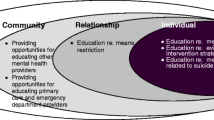Abstract
Suicide risk assessment and coping with the loss of a patient through suicide are two of the more challenging aspects of psychiatry residency. Over the last decade, the Department of Veterans Affairs has focused on a significant effort into the development of a comprehensive suicide prevention. This article aims to describe the initiatives and resources in place at the VHA to help address the issue of suicidal behavior in veterans and how residency programs can use this to enhance teaching of suicide prevention and postvention.

Similar content being viewed by others
References
Nock MK, Deming CA, Fullerton CS, Gilman SE, Goldenberg M, Kessler RC, et al. Suicide among soldiers: a review of psychosocial risk and protective factors. Psychiatry. 2013;76(2):97–125.
Melton BB, Coverdale JH. What do we teach psychiatric residents about suicide? A national survey of chief residents. Acad Psychiatry. 2009;33:47–50.
Pilkington P, Etkin M. Encountering suicide: the experience of psychiatric residents. Acad Psychiatry. 2003;27(2):93–9.
Chemtob CM, Hamada RS, Gauer G, Kinney B, Torigoe RY. Patients’ suicides: frequency and impact on psychiatrists. Am J Psychiatry. 1988;145:224–8.
Lerner U, Brooks K, McNiel DE, Cramer RJ, Haller E. Coping with a patient’s suicide: a curriculum for psychiatry residency training programs. Acad Psychiatry. 2012;36:29–33.
http://www.suicideoutreach.org/Defense Suicide Prevention Office (DSPO), Accessed 9 Jul 2013.
Suicide risk management training for clinicians, Veterans Health Administration.
www.veteranscrisisline.net. Accessed 7 Oct 2013.
Jobes DA. Managing suicidal risk: A collaborative approach. New York: Guilford Press; 2006.
http://www.mentalhealth.va.gov/coe/suicideprevention/. Accessed 17 Feb 2014.
American Journal of Public Health, Supplement 1. 2012;102:S1–60.
http://www.va.gov/oaa/gme_default.asp. Accessed 1 Jul 2013.
Mangurian C, Harre E, Reliford A, Booty A, Cournos F. Improving support of residents after a patient suicide: a residency case study. Acad Psychiatry. 2009;33:4.
Fang F, Kemp J, Jawandha A, Juros J, Long L, Nanayakkara S, et al. Encountering patient suicide: a resident’s experience. Acad Psychiatry. 2007;31(5):340–4.
Disclosures
On behalf of all authors, the corresponding author states that there is no conflict of interest.
Author information
Authors and Affiliations
Corresponding author
Rights and permissions
About this article
Cite this article
Pheister, M., Kangas, G., Thompson, C. et al. Suicide Prevention and Postvention Resources: What Psychiatry Residencies Can Learn from the Veteran’s Administration Experience. Acad Psychiatry 38, 600–604 (2014). https://doi.org/10.1007/s40596-014-0132-9
Received:
Accepted:
Published:
Issue Date:
DOI: https://doi.org/10.1007/s40596-014-0132-9




